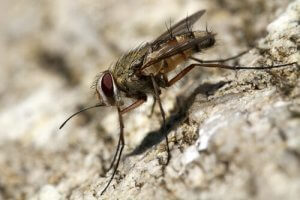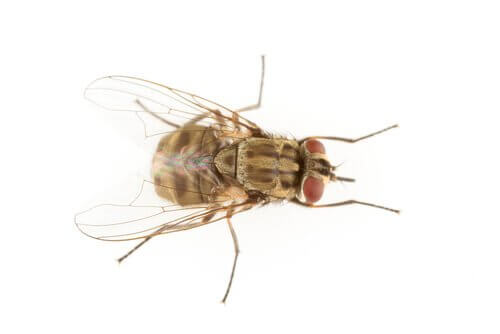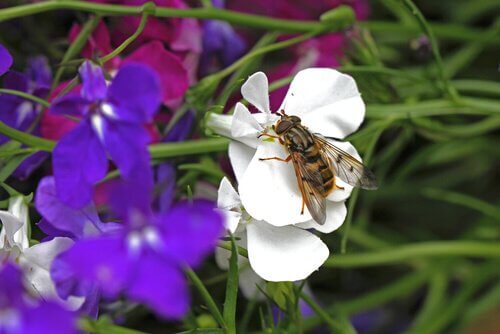Preventing Stable Flies on Dogs


Written and verified by the lawyer Francisco María García
Stable flies, or dog flies (Stomoxys calcitrans), are a type of hematophagous insect with parasitic habits. These flies mostly live in fields, farms and rural areas.
Normally, these insects parasitize animals that live in or around stables. Although they prefer to parasitize cows and horses, they can also infect dogs fairly frequently. In today’s article, we’ll tell you more about stable flies and how to prevent their bites.
What are stable flies?
Stable flies belong to the same family as the common flies we see all over the place. They’re included in the Stomoxys genus, which is also the genus of 20 other types of flies.
Their most characteristic feature is their proboscis. The insect uses this to bite its victims.
In general, these flies choose to bite their ‘victims’ in their most defenseless or hard-to-reach areas. When it comes to dogs, this means that their ears, snout, and legs are the most common areas to find bites. Although it’s rare, these flies can also bite humans and wild animals.
How do stable flies affect dogs?

Another risk is that wild flies can act as vectors for different types of bacteria. One bite can transmit a number of diseases to the animal that is bitten. They can also cause severe anemia and malnutrition.
However, the greatest danger these parasitic insects hold is that they usually bite their victim several times, which can cause an infestation on the dog’s body. Once the females flies find out the animal has been bitten, they will also quickly fly to that area to bite him and lay their eggs.
Once inside the dog’s body, these eggs will hatch and quickly give rise to an enormous amount of worms. At this point, your pet will be in danger of serious health problems.
In order to develop correctly, the stable fly larvae need to feed on organic matter. When they hatch inside the dog’s body, these worms will begin to feed on his tissues.
Because of the risks that this will cause, it’s essential to quickly treat the bite to avoid severe or irreversible damage to the animal’s health.
What should you do if your dog is bitten by a stable fly?
If a stable fly bites your dog, you should first wash the area where it bit him and clean the wound with plenty of clean water, or with antibacterial soap. Then, you should immediately take him to the vet so she can tell you if there are any other bites. After checking him out, she can prescribe the appropriate treatment.

At the clinic, the vet can perform a physical examination and request some tests to verify the dog’s state of health. She may also prescribe an antibiotic cream to keep the wounds from getting infected. If she does diagnose an infection, she will administer antibiotics orally or intravenously.
It’s very important that you monitor your pet’s health. If new symptoms start to appear, such as fever, inflammation, wounds or scabs on the skin, unpleasant odor, loss of appetite, presence of larvae, or extreme lethargy, you should take him back to the vet immediately.
How to avoid stable fly bites
To take care of your pet’s health, and to avoid stable fly bites, prevention is key. First, you have to keep up with the necessary preventative measures throughout your dog’s life.
Make sure he has a complete and balanced diet, that he’s getting enough physical and mental stimulation. He should also be up-to-date with his vaccines and deworming. This will help strengthen his immune system. Also, regular veterinarian check-ups are key to ensuring optimal development and good health.
Additionally, you can use repellents to keep stable flies and other harmful insects away. You can find spray and cream repellents in pet stores, as well as collars soaked with insecticides.
In the summer, especially when taking your dog for a walk in rural areas, it’s important to look out for these insects so you can keep your dog from getting bitten.
Stable flies, or dog flies (Stomoxys calcitrans), are a type of hematophagous insect with parasitic habits. These flies mostly live in fields, farms and rural areas.
Normally, these insects parasitize animals that live in or around stables. Although they prefer to parasitize cows and horses, they can also infect dogs fairly frequently. In today’s article, we’ll tell you more about stable flies and how to prevent their bites.
What are stable flies?
Stable flies belong to the same family as the common flies we see all over the place. They’re included in the Stomoxys genus, which is also the genus of 20 other types of flies.
Their most characteristic feature is their proboscis. The insect uses this to bite its victims.
In general, these flies choose to bite their ‘victims’ in their most defenseless or hard-to-reach areas. When it comes to dogs, this means that their ears, snout, and legs are the most common areas to find bites. Although it’s rare, these flies can also bite humans and wild animals.
How do stable flies affect dogs?

Another risk is that wild flies can act as vectors for different types of bacteria. One bite can transmit a number of diseases to the animal that is bitten. They can also cause severe anemia and malnutrition.
However, the greatest danger these parasitic insects hold is that they usually bite their victim several times, which can cause an infestation on the dog’s body. Once the females flies find out the animal has been bitten, they will also quickly fly to that area to bite him and lay their eggs.
Once inside the dog’s body, these eggs will hatch and quickly give rise to an enormous amount of worms. At this point, your pet will be in danger of serious health problems.
In order to develop correctly, the stable fly larvae need to feed on organic matter. When they hatch inside the dog’s body, these worms will begin to feed on his tissues.
Because of the risks that this will cause, it’s essential to quickly treat the bite to avoid severe or irreversible damage to the animal’s health.
What should you do if your dog is bitten by a stable fly?
If a stable fly bites your dog, you should first wash the area where it bit him and clean the wound with plenty of clean water, or with antibacterial soap. Then, you should immediately take him to the vet so she can tell you if there are any other bites. After checking him out, she can prescribe the appropriate treatment.

At the clinic, the vet can perform a physical examination and request some tests to verify the dog’s state of health. She may also prescribe an antibiotic cream to keep the wounds from getting infected. If she does diagnose an infection, she will administer antibiotics orally or intravenously.
It’s very important that you monitor your pet’s health. If new symptoms start to appear, such as fever, inflammation, wounds or scabs on the skin, unpleasant odor, loss of appetite, presence of larvae, or extreme lethargy, you should take him back to the vet immediately.
How to avoid stable fly bites
To take care of your pet’s health, and to avoid stable fly bites, prevention is key. First, you have to keep up with the necessary preventative measures throughout your dog’s life.
Make sure he has a complete and balanced diet, that he’s getting enough physical and mental stimulation. He should also be up-to-date with his vaccines and deworming. This will help strengthen his immune system. Also, regular veterinarian check-ups are key to ensuring optimal development and good health.
Additionally, you can use repellents to keep stable flies and other harmful insects away. You can find spray and cream repellents in pet stores, as well as collars soaked with insecticides.
In the summer, especially when taking your dog for a walk in rural areas, it’s important to look out for these insects so you can keep your dog from getting bitten.
This text is provided for informational purposes only and does not replace consultation with a professional. If in doubt, consult your specialist.








